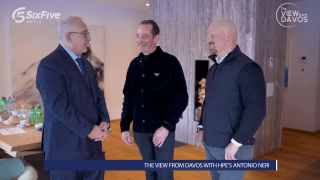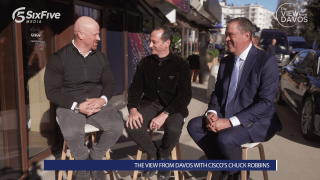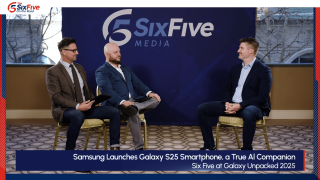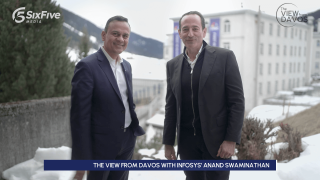Six Five Media covering Commvault SHIFT 2024! Hosts Daniel Newman and Patrick Moorhead are joined by Commvault’s CEO, Sanjay Mirchandani, for a conversation on the company’s strategic shift towards a cloud-first approach in cyber resilience. This transition has been marked by key acquisitions and partnerships, signaling a significant pivot in Commvault’s strategy to bolster cyber resilience in the cloud.
Their discussion covers:
- Commvault’s acquisitions of Appranix and Clumio to strengthen its cloud-first cyber resilience approach and its new partnerships with AWS and Google.
- The rationale behind acquiring Clumio, a former competitor specializing in AWS data and workload protection.
- An introduction of Appranix by Commvault and its impact as a game-changing product in the cloud resilience space.
- Strategy behind Commvault’s hefty partnership announcements with AWS and GCP, including hosting the Commvault Cloud platform on AWS and protecting Google Workspace.
- Insights into Commvault’s relationship with Azure and how it complements the company’s cloud-first cyber resilience strategy.
- An exploration of the concept of Continuous Business as discussed in Sanjay Mirchandani’s keynote at SHIFT, and how it differs from traditional notions of business continuity.
Learn more at Commvault.
Watch the video below, and check out our website so you never miss an episode.
Or listen to the audio here:
Disclaimer: Six Five Virtual Webcast is for information and entertainment purposes only. We may discuss publicly traded companies and reference equity share prices, but please do not take this as investment advice. We are not investment advisors.
Transcript:
Patrick Moorhead: The Six Five is back. And we are talking about cyber threats, cyber attacks, and the things that companies do to keep them from happening. Daniel, as we keep spreading all that data around, whether it’s from on-prem to cloud, the four different versions of Cloud API-driven, enterprise, SaaS, all of this stuff gets a lot more difficult, doesn’t it?
Daniel Newman: Yeah. It really is a trying time out there. If you’re a CIO or a CISO, there’s so much complexity as we continue to see the scale of data, companies have to be really thinking about how do they keep it safe? And AI has only been another catalyst for this concern. We’ve got these trends, Pat. We’ve got AI. We’ve got cloud, we’ve got multi-cloud, and now of course we’ve got cyber threats, and we’ve got companies needing to make sure they can utilize the data but keep their customers safe.
Patrick Moorhead: That’s right. It’s a big week in London. It’s Commvault’s annual big tent event called SHIFT, and they’re making a ton of announcements. In fact, they’ve already made those announcements and I can’t think of a better person to have this discussion with than Commvault CEO. Sanjay, welcome back to the show. Great to see you, and thanks for plugging in here on the big day in London.
Sanjay Mirchandani: Super excited to see both of you and be back at the show. Thank you.
Daniel Newman: Yeah, it is really great to have you. It’s been, I think about a year since you’ve joined us and in that year, so much progress, Sanjay has been made. I mean, big acquisitions, we’ll talk about all this, but you heard Pat and I in the lead up, a lot of cyber resilience. Now people might know Commvault for different things depending on backup, data recovery, and of course where you’re heading with all this cyber resiliency. We’d love to use this platform to show, to really get out there and talk about all the things you’re doing. And so you announced last year when you talked to us that you’re doubling down on the cyber resilience strategy. You’ve gone very strategic. You’ve made acquisitions, you have Appranix, you have Clumio. We see both as very entrenched in cloud. And now of course you’re deepening those partnerships in cloud with announcements with AWS and with Google. Cloud double down, cyber double down. Talk to us about how this all fits together.
Sanjay Mirchandani: Absolutely. So it’s been a year since we last chatted, and it was at the last SHIFT event in New York that we sort of pivoted the company from what we’ve done for so many years, which is really be known as the data protection company to a cyber resilience company because as in the lead up as customers and clients move to a multi-cloud world to pick the flavor of cloud, 70% of spend is going into a cloud-first mindset and protecting that capability is paramount because when everything lived in your data center, resilience was really about being able to bring your mission critical workloads back to life in a tried and tested way. And you had your clean room, and you tested the workloads and you had a little playbook and you felt good about things. Well, it’s different now. It’s very different.
Now you have on-premise workloads that are more legacy sometimes. You have edge-based workloads. You have SaaS platforms that you rent from folks to run applications. Your data live somewhere else. You’ve got your own cloud-native capabilities on different clouds. And all of this needs to be protected in a comprehensive way. I like to say just because somebody else helps you with the plumbing doesn’t mean you’re not responsible for the resilience. Okay. You’re absolutely responsible, and if your business is in the cloud, the cloud is your business. So let’s take a perspective on this, and that’s what we’ve done. We’ve built on what we said last year on resilience, true resilience, a company’s ability to come back to life, and now we’re extending it into a cloud-first perspective. And the acquisitions you mentioned are all playing into that strategy. So happy to dive into that with you.
Patrick Moorhead: Yeah, it sounds good. And it is interesting. Again, just going to keep reiterating, my favorite line is a hybrid multi-cloud fabric. And we need this for data. We need this for data protection. We need this for cyber resiliency that regardless of where the data is sitting, giving clients the ability to have a protection. From an investment basis or a value creation business, there’s three ways you can build something, right? You can build it organically over time with your own team. You can partner and you can acquire. You decided to buy one of your competitors that’s been out there for years, Clumio. They really focus on protecting AWS data and workloads. Can you talk me through that decision, build-buy partner?
Sanjay Mirchandani: Sure. So first of all, Patrick, the series of announcements we’ve made today include all of those. So we’re a company that prides itself on its innovation. We have over a thousand active patents and have had in the thousand range for a long, long time. So we pride ourselves on homegrown innovation, but the markets are moving so fast that the use cases are happening so quickly that we’re also in the past five and a half years, acquired a few companies that have really, I think, built on that. And then today we also announced some deep partnerships. Specifically on the core platform, we innovate on Commvault Cloud and Commvault Cloud as we announced last year, and we’ve continued to build this year disaggregates anything between on-premise and SaaS or cloud-based. It’s one single pane of glass that delivers true resilience for a company across all of it because we have one policy engine that manages everything for customers.
And then we’ve integrated a ton of security and threat detection, et cetera into that. That’s our core delivery capability. And it really doesn’t matter if it’s a SaaS-based capability or an on-premise capability. On top of that, we just announced that Clumio was part of the Commvault family, and I’ve always had a ton of respect for Clumio, and I’ve gotten to know the founders over the past couple of years. It’s a small industry.
Patrick Moorhead: Sure.
Sanjay Mirchandani: And their specialty around large data sets and massively recoverable S3 capabilities is what the future holds. When you look at the large gen AI buckets and where they’re storing the data and the scale at which the generative AI models and data sets are, this is the need of the moment. This massively scalable ability to sort of bring you back to life from something that either gets corrupted or gets ransomed is the need at the moment. And we’re really excited to have them as part of the family. And they’ve got some amazing technology that we showed on stage in stuff that hasn’t even been released yet, where we rolled back tens of billions of objects in minutes, which otherwise would’ve been unfathomable, how much time it would take, how expensive it would be, and how unreliable traditional methods would be. So we’re looking at that particular acquisition for this amazing technology and the smart folks there to help us build out the fabric on true multi-cloud resilience.
Daniel Newman: Yeah. And Sanjay, making these acquisitions, continuing to be disruptive and innovative, bringing in things that are kind of incremental and also truly shift the business is really hard. And then of course, you’ve got to do all the cultural stuff, this building, getting all these companies to come in and fit. And it seems that you’re off to a good path. And what we’re hearing at SHIFT seems that you’ve really kind of found some companies that make a lot of sense fit in. You could pretty immediately provide value to customers. I think these are all great steps. You also, you did a deal with Appranix, and that deal is now what about five or six months old?
Sanjay Mirchandani: April. I think we bought them in April.
Daniel Newman: Yeah. So April, talk a little bit about Appranix and why it’s such a game-changing product here and what’s coming here at SHIFT.
Sanjay Mirchandani: Absolutely. No, I’m really excited about what we’re doing with that technology. We’ve rebadged the technology after integrating it into the Commvault Cloud platform as Commvault Cloud Rewind. And in effect, that’s exactly what it does. It basically helps you rewind state. So if you have a Cloud-native app that your organization’s built that has just calls on a bunch of resources, they’re loosely coupled, they’re orchestrators, and on the surface seems all very easy, but when you have to bring back data, state, metadata and everything that goes with it and recompose the app and not lose what you had at the time that there was an event of some kind on any cloud is actually not that easy and is exactly what the future needs because as we build more Cloud-native apps after the lift and shift motion’s done, you’re going to need to be able to protect them.
And again, protecting these Cloud-native apps, these loosely coupled, orchestrated apps in the way we did traditional things is just not going to work. Okay? And it needs a different level of compliance and resilience. When you think about Rewind, you’re literally bringing it back to a previous state, all of it. And so the subtlety in what we’re doing here, guys, is we’re extending the platform for both breadth and depth. So on Commvault Cloud, we’ve always been known for no workload left behind. Today we’re saying no cloud left behind with some of the partnerships that we’re announcing and no application left behind. So whether it’s a Cloud-native app or a VM or a SaaS app, we’re going to make sure you’ve got resilience across all of it. And with the Clumio acquisition, we’re going super deep with, in this case, S3 or the next gen apps that are built on S3. We’re really trying to both go this way and in certain cases go super deep because the technology needs are that way.
Patrick Moorhead: Yeah, breadth and depth is the name of the game here. Again, no data left behind and wherever it is. And with data increasingly going into more places, you have to have organic growth, collaborate and also to get to time to market by companies. So speaking of S3, you’re making some hefty announcements today with AWS and GCP. You host Commvault Cloud with AWS, and you also announced that you’re protecting Google Workspace. Can you talk about the strategy there? Some people might think, oh, it might be different type of arrangement there.
Sanjay Mirchandani: Well, really we want to be complete for customers. We’ve had support from Microsoft 365 and all its components for a long time, and customers have been asking us for the Google side of things. And with this, we absolutely natively support all things in the Google Workspace. Shared drives, Google Drive, email natively like we do other productivity suites. So we’re excited about that. Customers get a complete set of choices from us.
Daniel Newman: It’s super interesting, Sanjay. And as you’re talking about that all of a sudden comes to my mind is AI and actually the stunning fact that we’ve gone four or five questions and not really asked you much about AI. And I just want to drill down on something you just answered there in the last question before I get onto what I was originally planning, and that is AI driving a lot of simplicity here? Is this part because you haven’t said the words a lot and I kind of love it and I’m kind of nervous about it.
Sanjay Mirchandani: No, don’t be nervous. I love to just throw AI around because-
Daniel Newman: Appreciate that.
Sanjay Mirchandani: … it’s just the way it is. We’re using AI in a few very specific ways. First and foremost, customers trust us with their data. We want to be responsible with anything and everything we do with the data so we don’t lose sight of our responsibility. Now, the fact that we sit on exabytes of data or manage exabytes of data for customers is an opportunity, but we have to be super cautious about how we think about that. The first thing we’re doing with AI and machine learning in particular is giving customers the ability to recover. Now, if you’ve been attacked and there’s chaos that happens when that happens, the best laid plans are great, but you actually don’t have the forensics to know when to start recovering from. The number one use case for us to help customers with AI or machine learning or both is giving them a predictable point to start the recovery from.
And so I’m not going to pepper myself saying, I’m going to do primary AI. No, no, I’m going to use the intelligence we gathered through the process of our technology to give customers a great starting point when they need it most. Okay? That’s number one. Number two is protecting AI apps. There’s a lot of provenance that goes into these next generation big AI apps that are going to start getting built, and there’s data and models and output and applications and layers of application that all have to be kept together. There is provenance in this, and we think we have a huge role to play. And I think the Clumio technology will lend itself to a lot of that.
And the third is one that we don’t talk too much about, but we’re putting AI into our technology within the customer tenant, within the customer implementation to enable better use of our technology. For example, automating API usage. Okay? We’ve got smart capabilities that are AI based that attach our stuff to the customer service catalog as an example. So there’s really three facets to it, and we’d rather deliver as we do at Commvault. We’d rather come out and show you how we’re doing things to help you as opposed to just talking about the hype cycle if you would.
Daniel Newman: And I appreciate you not feeling obligated to do that. I think both Pat and I, we’re bouncing between at times how excited to be about AI and how practical it can be. Sounds like you have a very practical relationship with it. Now, real quickly, you’ve been very focused on partnership, but I haven’t heard Azure come out of your mouth. I mean, that seems like it would be one you’d want to also be involved with.
Sanjay Mirchandani: We go back to the inception of this company with Microsoft in many ways, okay? And a lot of our tech was built on a Microsoft stack. Our first… Metallic was released on Azure. It’s a true cross-cloud. It’s a true multi-cloud capability, but there are customers that want certain capabilities in the cloud of their choice. And today’s announcements are more about talking about the extensions there as opposed to not doing something with Microsoft. It is absolutely a fabulous relationship with Microsoft. In fact, Andy Aldous, corporate vice president for security, spoke at our conference, so there’s a very deep relationship across the board.
Patrick Moorhead: Sanjay, just to wrap up here, I want to talk a little bit about what you talked about on stage, and you used the terminology or the phraseology continuous business. Can you talk a little bit about how that might be different from, let’s say, business continuity that we’ve been talking about for a long time?
Sanjay Mirchandani: Yeah. Business continuity to me is static. Okay? It’s a certain set of protocols, certain set of runbooks, certain rooms that were dedicated in the event that something bad was to happen. And usually the bad wasn’t about cyber. It was human error. It natural disasters. It was equipment failure. To be honest, I was a CIO. That’s the mindset that it grew from. And the world we live in today is a constantly connected, very distributed, and data has never been used further away from where it was created. Let’s just be honest when you look at the data lakes and everything else. The entire paradigm of what running a business means today, continuous business as we’ve coined it is super different.
To me, business continuity by definition is static, and our businesses are not static or anything but static. And so it’s really turning that on its head and saying, now what do we need to do? So things like continuous readiness, being able to test your capabilities real time at scale for every workload, continuous security. It’s not a bolt on. If there’s a threat detected on the perimeter, I’m using that for my backup. If I detect a threat, I’m sending that back. Continuous recovery.
Patrick Moorhead: Okay.
Sanjay Mirchandani: Being able to recover… So it’s not just a cute thing that we’re saying, oh, we turn it around, but in my mind it goes from static-
Patrick Moorhead: Right.
Sanjay Mirchandani: … to dynamic.
Daniel Newman: Well, Sanjay, I want to thank you so much. We know you are at SHIFT and you’re with your customers, your partners, your employees. It’s a big moment for the company. We’ve really enjoyed the opportunity both this year and last year to have the chance to sit down with you, and the progress has been palpable. So congratulations on all that. We’d love to continue to follow the journey, and continue to watch the company grow. We know how important this trend is, and it’s great to see a company that is shifting with the market and also just doubling down. Sanjay, really appreciate how you’ve practically applied all these trend lines to meeting customers where they are. This is both what Patrick and I talk about a lot on our pod. It’s not just using trends and buzz. It’s about really delivering solutions that create value. Let’s have you back again soon. Let’s do this at least at the next SHIFT, if not before. Congratulations on the success. Talk to you soon.
Sanjay Mirchandani: Thank you both.
Daniel Newman: And thank you everyone out there for being part of The Six Five. We’re on the road at Commvault SHIFT virtually. They’re in London. We are here in the States. Look forward to catching up with all of you. Hit that subscribe button, check out the show notes for more information on all of the things that we talked about today. It’s time to say goodbye for now though. We’ll see you soon.






















































































